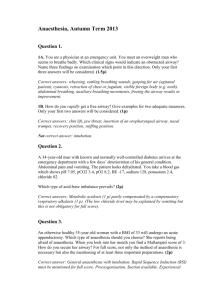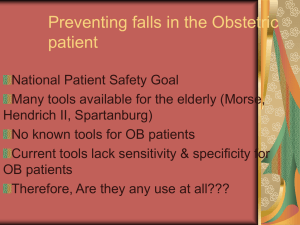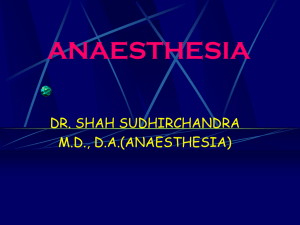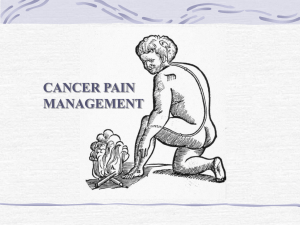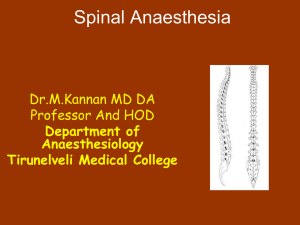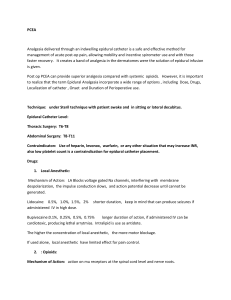click here
advertisement
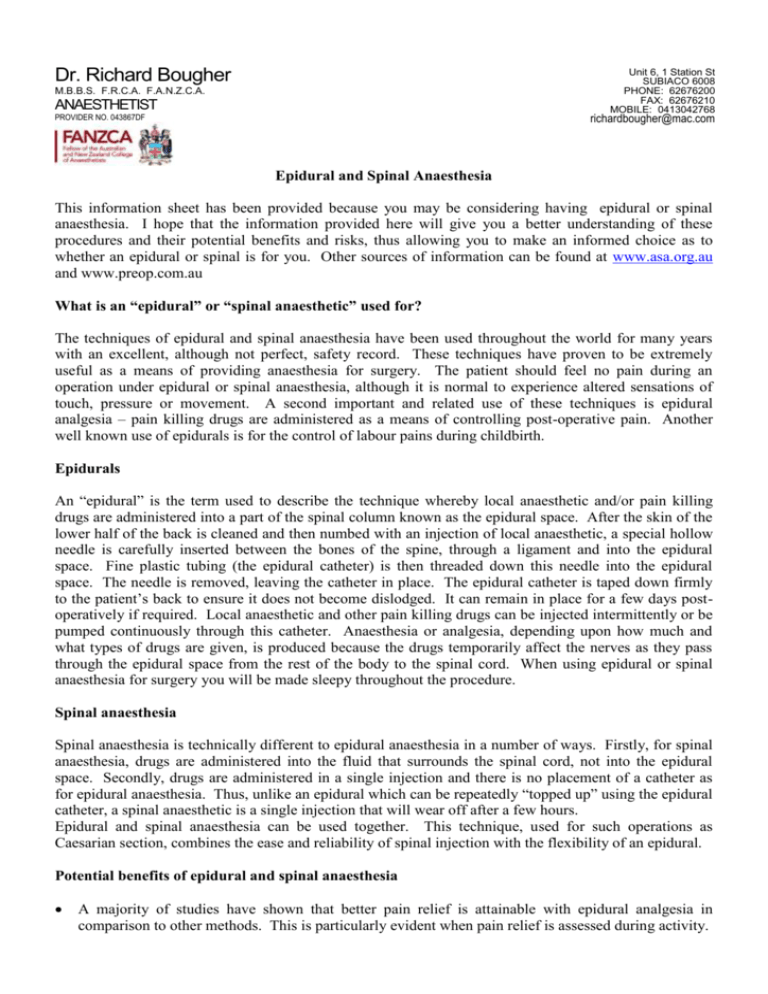
Dr. Richard Bougher Unit 6, 1 Station St SUBIACO 6008 PHONE: 62676200 FAX: 62676210 MOBILE: 0413042768 M.B.B.S. F.R.C.A. F.A.N.Z.C.A. ANAESTHETIST richardbougher@mac.com PROVIDER NO. 043867DF Epidural and Spinal Anaesthesia This information sheet has been provided because you may be considering having epidural or spinal anaesthesia. I hope that the information provided here will give you a better understanding of these procedures and their potential benefits and risks, thus allowing you to make an informed choice as to whether an epidural or spinal is for you. Other sources of information can be found at www.asa.org.au and www.preop.com.au What is an “epidural” or “spinal anaesthetic” used for? The techniques of epidural and spinal anaesthesia have been used throughout the world for many years with an excellent, although not perfect, safety record. These techniques have proven to be extremely useful as a means of providing anaesthesia for surgery. The patient should feel no pain during an operation under epidural or spinal anaesthesia, although it is normal to experience altered sensations of touch, pressure or movement. A second important and related use of these techniques is epidural analgesia – pain killing drugs are administered as a means of controlling post-operative pain. Another well known use of epidurals is for the control of labour pains during childbirth. Epidurals An “epidural” is the term used to describe the technique whereby local anaesthetic and/or pain killing drugs are administered into a part of the spinal column known as the epidural space. After the skin of the lower half of the back is cleaned and then numbed with an injection of local anaesthetic, a special hollow needle is carefully inserted between the bones of the spine, through a ligament and into the epidural space. Fine plastic tubing (the epidural catheter) is then threaded down this needle into the epidural space. The needle is removed, leaving the catheter in place. The epidural catheter is taped down firmly to the patient’s back to ensure it does not become dislodged. It can remain in place for a few days postoperatively if required. Local anaesthetic and other pain killing drugs can be injected intermittently or be pumped continuously through this catheter. Anaesthesia or analgesia, depending upon how much and what types of drugs are given, is produced because the drugs temporarily affect the nerves as they pass through the epidural space from the rest of the body to the spinal cord. When using epidural or spinal anaesthesia for surgery you will be made sleepy throughout the procedure. Spinal anaesthesia Spinal anaesthesia is technically different to epidural anaesthesia in a number of ways. Firstly, for spinal anaesthesia, drugs are administered into the fluid that surrounds the spinal cord, not into the epidural space. Secondly, drugs are administered in a single injection and there is no placement of a catheter as for epidural anaesthesia. Thus, unlike an epidural which can be repeatedly “topped up” using the epidural catheter, a spinal anaesthetic is a single injection that will wear off after a few hours. Epidural and spinal anaesthesia can be used together. This technique, used for such operations as Caesarian section, combines the ease and reliability of spinal injection with the flexibility of an epidural. Potential benefits of epidural and spinal anaesthesia A majority of studies have shown that better pain relief is attainable with epidural analgesia in comparison to other methods. This is particularly evident when pain relief is assessed during activity. The use of these techniques can provide an alternative to general anaesthesia. This is a consideration not only for high risk patients in terms of safety, but also for other patients by reducing post-operative sleepiness, nausea and vomiting. These techniques may reduce the incidence of some post-operative complications, although this is a controversial and complex topic. For example there is evidence for a reduced incidence of venous and arterial thrombosis; an improved recovery of gastrointestinal function after bowel surgery; and reduced respiratory complications in high risk patients. Potential complications and risks Technical problems may occur. It can sometimes, for example, be difficult to locate the epidural space. Incomplete or one sided blockade of pain may occur. Although this situation can usually be remedied, it may sometimes be necessary to re-insert the epidural catheter. General anaesthesia can be used as a back up. A decrease in blood pressure, especially at the start of an epidural or spinal block, is anticipated and is usually readily treated. This may cause you to feel light-headed, dizzy or nauseous. A temporary hearing impairment may occur after spinal anaesthesia. Headache can be a side effect of epidural and spinal anaesthesia, and is caused by a persistent leak of spinal fluid from the site where the needle entered the spinal column. This occurs in approximately 1 in every 200 epidural administrations and 1 in every 50 spinal administrations. In cases where the headache is persistent or severe, successful treatment is very likely through the use of an epidural blood patch. There has been some concern that the use of epidurals may lead to persistent back pain. There is currently no good evidence to support this. Itchiness, urine retention and nausea can occur. If these effects occur they are generally treatable. A serious potential complication is damage to spinal nerves due to infection, haematoma (blood clot), injection of the wrong drug, or interruption of arterial blood supply. This damage can result in patches of numbness, muscle weakness, reduced bladder or bowel function, paraplegia and even death. The chance of permanent patches of numbness or weakness is probably less than 1 in 15,000, and that of a spinal haematoma less than 1 in 150,000. The risk of developing such a serious neurological complication is remote when performed by someone who is experienced, and when ongoing care is provided by staff who are experienced in the management of epidurals. Recovery from epidural or spinal anaesthesia The vast majority of patients recover totally uneventfully after epidural or spinal anaesthesia, however you should seek medical advice or contact me (0413042768 or 62676200) if there is: Severe constant back pain often in association with disturbances of bowel or bladder function, or leg weakness. This may indicate infection in the spinal canal and it may occur up to a few weeks after having had an epidural or spinal. This condition is serious but very rare. Persistent headache that was not present before the epidural or spinal anaesthetic.
